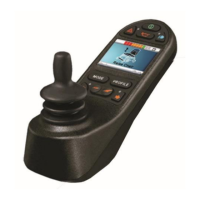CHAPTER 10 – DIAGNOSTICS
1 INTRODUCTION
The primary objective of this chapter is to assist service personnel in finding the likely area of a detected trip within the whole
wheelchair electrical system. It is important to realize that even though the control system is signalling a trip, it may not be the
control system itself that is defective. This is because the control system is able to detect problems in other electrical
components (motors, batteries, solenoid brakes, etc.) or, more importantly, the wiring to them. When a control system has
detected a trip, a system trip is indicated.
This chapter covers the diagnostic process when working with an LCD based JSM or a DTT. If just a JSM-LED is being used, refer
to section Control System Status Indication in Chapter 4.
WARNING:
Diagnostics should only be conducted by healthcare professionals with in-depth knowledge of Curtiss-Wright electronic
control systems. An incorrect or badly effected repair could result in an unsafe set-up of a wheelchair. Curtiss-Wright accepts
no liability for losses of any kind arising from an incorrect or badly effected repair.
1.1 DIAGNOSTIC PROCEDURE
To diagnose a trip please follow this procedure:
Read and note the Trip Text displayed, the Identified Module and the Trip Code. Refer to section 2.
Switch off the control system.
Make sure that all connectors on the listed Module and the wheelchair are mated securely.
Check the condition of the battery.
Find the definition of the Trip Text, and take the required action. Refer to section 3.
Switch on the control system again and try to drive the wheelchair. If the safety circuits operate again, switch off and
do not try to use the wheelchair.
Contact your service agent.
2 DIAGNOSTIC SCREENS
2.1 CURRENT DIAGNOSTIC SCREEN
When the control system safety circuits have operated and the control system has been prevented from moving the wheelchair
a diagnostics screen will be displayed.
This indicates a system trip, i.e. the R-net has detected a problem somewhere in the wheelchair’s electrical system.
If the error is in a non-active module, for example in the ISM but with a Drive Mode selected, then drive will still be possible,
however, the diagnostic screen will appear intermittently.

